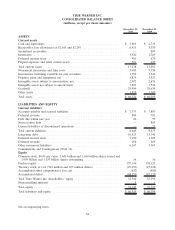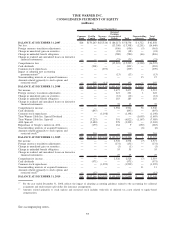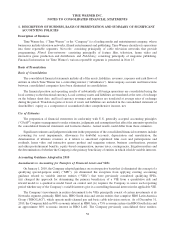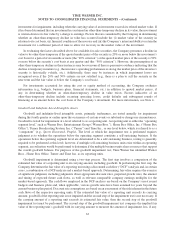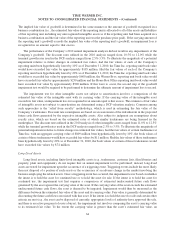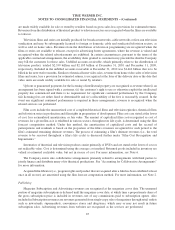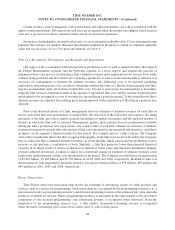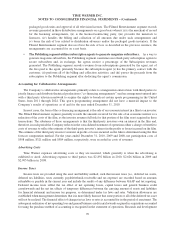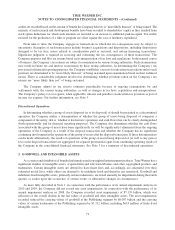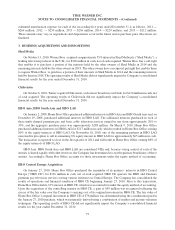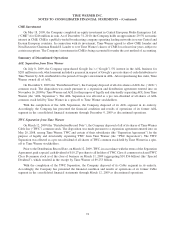Time Magazine 2010 Annual Report Download - page 76
Download and view the complete annual report
Please find page 76 of the 2010 Time Magazine annual report below. You can navigate through the pages in the report by either clicking on the pages listed below, or by using the keyword search tool below to find specific information within the annual report.The implied fair value of goodwill is determined in the same manner as the amount of goodwill recognized in a
business combination (i.e., the estimated fair value of the reporting unit is allocated to all of the assets and liabilities
of that reporting unit including any unrecognized intangible assets as if the reporting unit had been acquired in a
business combination and the fair value of the reporting unit was the purchase price paid). If the carrying amount of
the reporting unit’s goodwill exceeds the implied fair value of the reporting unit’s goodwill, an impairment loss is
recognized in an amount equal to that excess.
The performance of the Company’s 2010 annual impairment analyses did not result in any impairments of the
Company’s goodwill. The discount rates utilized in the 2010 analysis ranged from 10.5% to 12.0% while the
terminal growth rates used in the DCF analysis ranged from 2.5%-3.5%. To illustrate the magnitude of a potential
impairment relative to future changes in estimated fair values, had the fair values of each of the Company’s
reporting units been hypothetically lower by 10% as of December 31, 2010, the Time Inc. reporting unit book value
would have exceeded fair value by approximately $105 million. Had the fair values of each of the Company’s
reporting units been hypothetically lower by 20% as of December 31, 2010, the Time Inc. reporting unit book value
would have exceeded fair value by approximately $600 million, the Warner Bros. reporting unit book value would
have exceeded fair value by approximately $250 million and the Home Box Office reporting unit book value would
have exceeded fair value by approximately $500 million. If this were to occur, the second step of the goodwill
impairment test would be required to be performed to determine the ultimate amount of impairment loss to record.
The impairment test for other intangible assets not subject to amortization involves a comparison of the
estimated fair value of the intangible asset with its carrying value. If the carrying value of the intangible asset
exceeds its fair value, an impairment loss is recognized in an amount equal to that excess. The estimates of fair value
of intangible assets not subject to amortization are determined using a DCF valuation analysis. Common among
such approaches is the “relief from royalty” methodology, which is used in estimating the fair value of the
Company’s tradenames. Discount rate assumptions are based on an assessment of the risk inherent in the projected
future cash flows generated by the respective intangible assets. Also subject to judgment are assumptions about
royalty rates, which are based on the estimated rates at which similar tradenames are being licensed in the
marketplace. The discount rates utilized in the 2010 analysis of other intangible assets ranged from 11.0% to 12.5%
while the terminal growth rates used in the DCF analysis ranged from 2.5% to 3.5%. To illustrate the magnitude of
potential impairment relative to future changes in estimated fair values, had the fair values of certain tradenames at
Time Inc. with an aggregate carrying value of $809 million been hypothetically lower by 10%, the book values of
certain of those tradenames would have exceeded fair values by $11 million. Had the fair values of those tradenames
been hypothetically lower by 20% as of December 31, 2010, the book values of certain of those tradenames would
have exceeded fair values by $74 million.
Long-Lived Assets
Long-lived assets, including finite-lived intangible assets (e.g., tradenames, customer lists, film libraries and
property, plant and equipment), do not require that an annual impairment test be performed; instead, long-lived
assets are tested for impairment upon the occurrence of a triggering event. Triggering events include the more likely
than not disposal of a portion of such assets or the occurrence of an adverse change in the market involving the
business employing the related assets. Once a triggering event has occurred, the impairment test is based on whether
the intent is to hold the asset for continued use or to hold the asset for sale. If the intent is to hold the asset for
continued use, the impairment test first requires a comparison of estimated undiscounted future cash flows
generated by the asset against the carrying value of the asset. If the carrying value of the asset exceeds the estimated
undiscounted future cash flows, the asset is deemed to be impaired. Impairment would then be measured as the
difference between the estimated fair value of the asset and its carrying value. Fair value is generally determined by
discounting the future cash flows associated with that asset. If the intent is to hold the asset for sale and certain other
criteria are met (e.g., the asset can be disposed of currently, appropriate levels of authority have approved the sale,
and there is an active program to locate a buyer), the impairment test involves comparing the asset’s carrying value
to its estimated fair value. To the extent the carrying value is greater than the asset’s estimated fair value, an
64
TIME WARNER INC.
NOTES TO CONSOLIDATED FINANCIAL STATEMENTS – (Continued)


